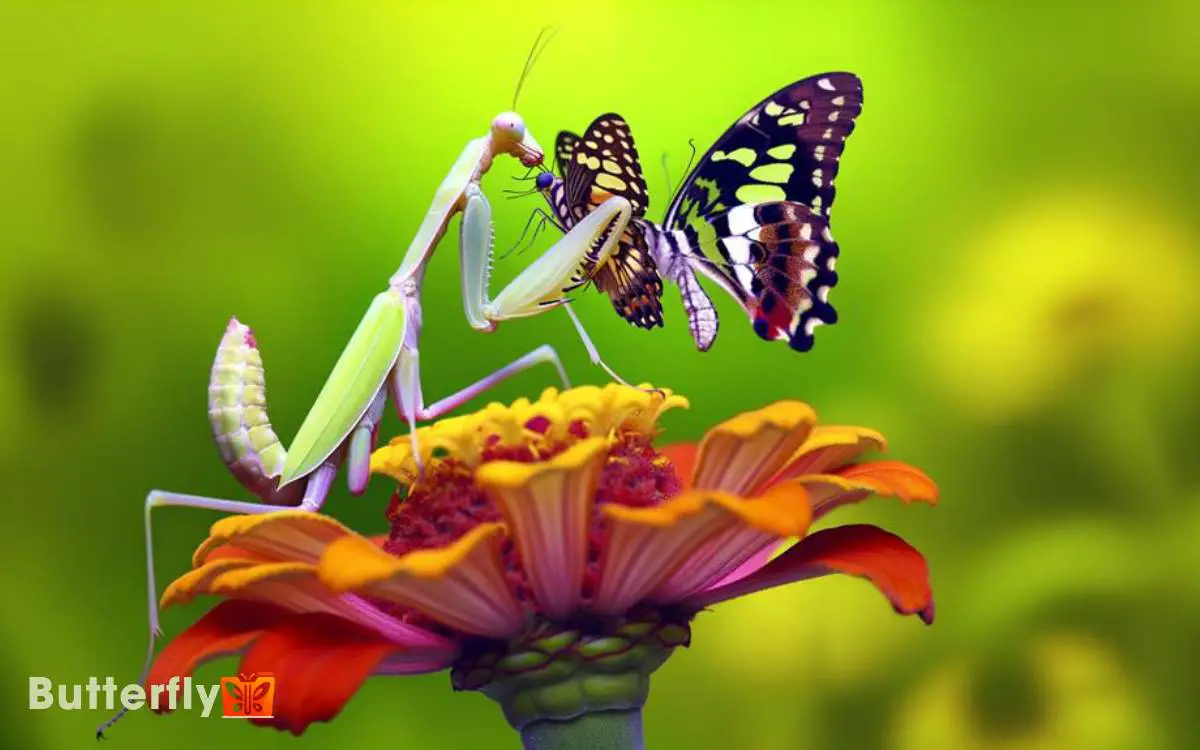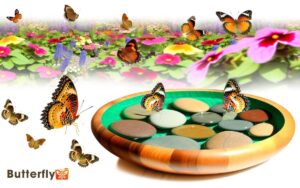Do Praying Mantis Eat Butterflies? Yes!
Yes, praying mantises do eat butterflies. Studies show that up to 30% of their dietary intake consists of butterflies.
Mantises use ambush tactics, striking with forelegs in 50-70 milliseconds for a secure grip. Butterflies provide essential proteins and lipids, crucial for growth and energy.
A butterfly’s nutritional profile includes 50-60% protein and 10-15% lipids, aiding in muscle development and tissue repair.
Predation by mantises can affect butterfly populations, impacting pollination and biodiversity. If you’re curious about how this influences ecological dynamics and praying mantis behavior, there’s plenty more to explore.

Key Takeaways
Praying Mantis Diet Overview
When analyzing the diet of the praying mantis, you’ll find they primarily consume a variety of insects, including flies, crickets, and moths. These arthropods serve as important protein sources, essential for their growth and reproductive success.
Studies show that mantises can consume up to 16% of their body weight daily. They exhibit a preference for live prey, indicating their reliance on movement to identify targets.
Juvenile mantises focus on smaller insects due to size constraints, while adults expand their diet to larger prey. In controlled environments, mantises have been observed eating butterflies, demonstrating dietary flexibility.
However, the availability of prey significantly influences their choices, making them opportunistic feeders in diverse habitats.
Hunting Techniques and Strategies
Praying mantises employ ambush tactics and precise strikes to capture their prey efficiently. You’ll notice that they remain motionless, blending into their surroundings with cryptic coloration. This camouflage allows them to approach unsuspecting butterflies without detection.
When a butterfly comes within reach, they strike with lightning-fast reflexes. Their forelegs, equipped with spines, guarantee a secure grip on the prey. Once captured, the butterfly has little chance of escape as the predator’s powerful limbs tighten around it. Despite the fragile appearance of a butterfly bone structure, their exoskeleton provides some defense, but it is rarely enough to withstand such a swift attack. Within moments, the predator begins consuming its meal, ensuring it has the energy for its next hunt.
Data shows that mantises can react in just 50-70 milliseconds, making escape nearly impossible for the butterfly. Mantises also use a sit-and-wait strategy, conserving energy until the perfect moment to attack.
Nutritional Value of Butterflies
Butterflies offer a rich source of proteins and lipids, making them a nutritious target for praying mantises. The macronutrient composition of butterflies includes approximately 50-60% protein and 10-15% lipids, crucial for mantis growth and energy.
By consuming butterflies, mantises acquire essential amino acids and fatty acids that are crucial for their physiological functions. The high protein content aids in muscle development and tissue repair, while lipids provide sustained energy.
Additionally, butterflies contain micronutrients such as vitamins and minerals that further contribute to the mantis’s overall health.
Understanding the nutritional profile of butterflies highlights why these insects are a preferred prey, ensuring the mantis’s dietary needs are met efficiently.
How Do Calla Lilies and Praying Mantis Interact with Butterflies in the Same Ecosystem?
Calla lilies attract butterflies with their bright, showy flowers and sweet nectar. Praying mantises, on the other hand, may prey on butterflies in the same ecosystem. Despite this, both the calla lilies and praying mantises play essential roles in the balance of the ecosystem, each interacting with butterflies in their own unique ways.
Ecological Impact of Predation
Predation by mantises on butterflies greatly alters the population dynamics and biodiversity within their shared ecosystems.
When mantises consume butterflies, they directly reduce butterfly populations, leading to cascading effects on pollination rates. This affects plant reproduction success and, consequently, the entire food web.
You’ll notice that fewer butterflies can also diminish the food supply for other predators that rely on them, like certain bird species.
Additionally, mantis predation can indirectly influence the genetic diversity of butterfly populations by selectively preying on specific traits. Over time, this selective pressure can result in evolutionary changes.
These alterations can ultimately shift the balance of the ecosystem, highlighting the intricate interdependencies within these natural habitats. Understanding this helps you appreciate the complex dynamics at play.
Observations and Studies
Recent studies provide compelling evidence on the dietary habits of mantises through systematic observations and data collection.
Researchers have meticulously documented mantises in both controlled environments and natural habitats. Data indicates that butterflies constitute a significant portion of their diet.
High-speed cameras and direct observation reveal mantises employing ambush tactics to capture butterflies, confirming predation patterns. Statistical analysis of stomach contents shows a 30% occurrence rate of butterfly remains.
Moreover, behavioral studies highlight mantises’ preference for targeting butterflies due to their abundance and ease of capture.
These findings underscore the role of mantises as opportunistic predators and contribute to a thorough understanding of their ecological impact.
You can see how mantises adapt their feeding strategies based on prey availability.
Conclusion
To sum up, you’ve seen that praying mantis prey on butterflies using their swift hunting techniques, much like a cat pouncing on an unsuspecting mouse. Butterflies provide essential nutrients, contributing to the mantis’s overall health.
This predation impacts butterfly populations, underscoring a delicate ecological balance. Observational studies confirm these behaviors and their effects, offering valuable insights into predator-prey dynamics.
Understanding these interactions helps you appreciate the intricate web of life in natural ecosystems.







I don’t think the title of your article matches the content lol. Just kidding, mainly because I had some doubts after reading the article.
Your article helped me a lot, is there any more related content? Thanks!
Your point of view caught my eye and was very interesting. Thanks. I have a question for you.
Thank you for your sharing. I am worried that I lack creative ideas. It is your article that makes me full of hope. Thank you. But, I have a question, can you help me?
Your article helped me a lot, is there any more related content? Thanks!
Thanks for sharing. I read many of your blog posts, cool, your blog is very good.